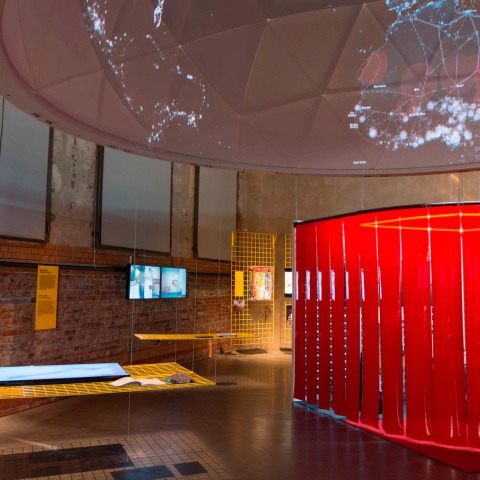At the 2016 Oslo Architecture Triennale, Rotterdam-based team from OMA and Oslo-based interaction designers Bengler showed PANDA, a startup that addresses the social and political implications of digital sharing platforms such as Uber and Airbnb, as well as their impact on the built environment.
In the middle of room a red plastic strip curtain demarcates a space that could have been teleported from an apartment of a hacker. A grid of sticky notes inscribed with the names of various sharing platforms on one wall, while on another a poster maps their global impact. On a desk a six-monitor computer displays various images of countercultural resistance, tagged and sorted by theme. Next to it sits a bottle of Provigil—a wakefulness medication commonly (ab)used for all-nighters by college students—and a stack of news clippings exposing the ills of the sharing economy.
Dubbed PANDA, the “counter-organizational platform” both critiques the sharing economy and, in classic OMA-fashion, wryly critiques that critique.
Description of the project by OMA and Bengler
PANDA investigates the accelerating influence of digital sharing platforms, their social and political implications, and pervasive impact on the built environment.
In the early 2000s, the democratic spaces of the web were greeted as an alternative to centralized commercial and social structure; in 2007, after the financial landslide, the sharing gospel gave hope to those struggling to make a living.
The boom of “sharing platforms” provided the private sphere with powerful market mechanics, enabling the fluid commodification of life. Flexible, web-scale human resourcing drew “app freelancers” into the gig economy — an unprecedented economic reactivation of latent human assets. A new labor force emerged, one obliged to hire itself out for ever-smaller jobs with no safety net, as companies profited handsomely.
While sharing platforms employ organizational tools of savage power, masses are atomized — strong-armed into unorganized negotiation.
Crowds attack taxis and block streets as services are banned in countries around the world. Unrest is staged against app-based, short-term accommodation platforms and the conversion of entire buildings into de facto hotels.
PANDA is a counter-organizational platform, providing a tactical disruption-as-a-service toolkit, empowering app workers with the means to mediate terms with the platforms and their algocrat masters.
That the service materialized out of Kinshasa is probably a fabrication. Skirting traditional venture capital cycles, it nevertheless emerged as a distributed, open source network of for-profit tactical nodes. Untraceable and decentralized, a system of vast data and self-regulating algorithmic control.
PANDA is at once an act of resistance and a business opportunity, conceived within the cultural framework and space of new digital economic realms. It is the antibody of metastasizing platform capitalism.
Within mere months, PANDA experienced dramatic expansion, crystallizing the masses in tactical just-in-time action groups: from intangible interventions to exaggerated physical transformations.
As software eats the world, as everything solid melts into air, PANDA recasts technologies of oppression into a machinery of individual empowerment. By providing tools to actively navigate the turmoils of new digital regimes, PANDA fosters a new sense of belonging and purpose.
PANDA has been led by OMA’s Ippolito Pestellini Laparelli and Bengler’s Even Westwang and Simen Svale Skogsrud. It is part of the On Residence exhibition, on display at the National Museum of Architecture.






































